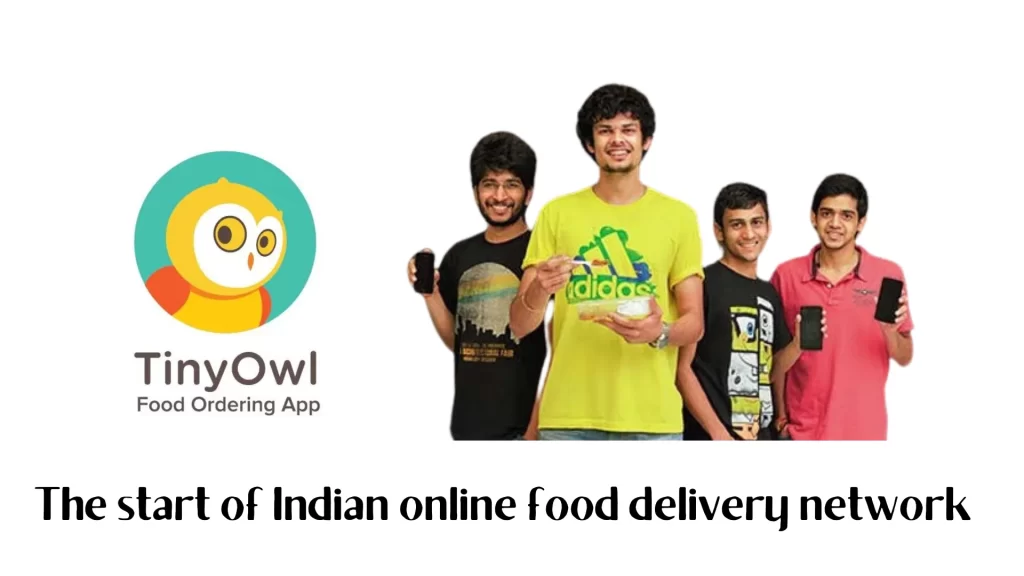Tinyowls Indian market for online food delivery
Tinyowl was the first startup in India to connect the restaurant business chain
Whether it is a restaurant owner, chef, supplier, or customer.
Why did this Startup fail in just 2 years despite being a first-mover advantage, the best team, and worldwide funding?
What are the most important business lessons that we can learn from this case study and implement in our business?
if you are an entrepreneur or want to become venerable then this case study is the goldmine for you.
How Tinyowl started!
this story begins in 2014 when Harshvardhan Mandad starts the business Tinyowl with his 12 friends.
This business was so tremendous that it revolutionized all the restaurant businesses in India.
And if this startup existed today, then no one would even ask Zomato and Swiggy
Harshvardhan identifies a huge gap in the restaurant business and that gap was
Restaurants owner and chefs wanted to grow their businesses but had no resources to do so
this is where Tinyowl comes into the Game
Harshvardhan observed that there was a connectivity gap between the restaurant owner and the customer.
Due to this, the customers did not trust the restaurant and the restaurant did not know how to acquire a customer
Harshvardhan made Nashik such a platform that connected the customer to the restaurant but also gave the customers something that made them addicted to this businessThat was DECISION-MAKING CONVENIENCE.

DECISION-MAKING CONVENIENCE
Now understand this thing very carefully.
Have you ever wondered why Swiggy and Zomato always come to your mind when you feel hungry?
Whereas most of the time, we do not even know whether the food we ordered will be okay or not.
Still, none of us thinks of cooking, so let me tell you there is only one reason.
NEURAL PROGRAMMING
All these companies have changed our behavioural design targeting our subconscious minds.
Which we do not know in real but we are all victims of it
Interesting this behavioural change was first initiated by Tinyowl
But today none of us even know this startup
The question is, why and how did a startup that was growing at a rate of 200% every month fail today?
So to understand these things, it is most important for you to understand these three things.
COMPANY FORENSICS
Tinyowl company looked very successful, the investors were so confident that the company picked up funds worth Rs 200 crore in 1.5 years only.
But something was going on inside the company which was neither visible to the investor nor to customers.
Have questioned what was going on inside this company which proved to be so dangerous for this company.
When TinyOwl was in its initial stage, the role of the company was divided in this way.
Co-founder Harshvardhan used to sell the company’s vision to the investor and bring funds for the company.
And the rest of those who were co-founders did all the operations management
Now comes a problem in this thing, that problem comes when there is a synergy gap between co-founders
Let me explain very simply, remember the days of pocket money
Earlier we used to get pocket money from our parents but after getting it, it was up to us how we spend it
Now suppose you took your pocket money and gave it to your friend but you do not know how he is using it
This same thing was happening with Tinyowl too.

Harshvardhan was a great salesman that’s why by selling his vision he used to raise the funds from investors
But he never paid any attention to where that money is being used.
Tinyowl means Restaurant, chef, supplier, customer all under one roof
Even it was so tremendous that you can see the profile of the chef cooking in the restaurant.
Harshvardhan sell his vision in such a way that his funds had crossed more than 200 crores in series B.
Tinyowl’s growth was 4x more than that of Swiggy and Zomato’s
His customers were so happy with him that 40% of the customers themselves used to go and tell everyone to use TinyOwl
And why don’t, you get food sitting at home, you know who has prepared your food and if you want food like home, then you can get it like it.
If all this happens then why won’t anyone tell
Mumbai, Bangalore, Delhi, Pune within 1.5 years of starting, they expanded to 11+ cities
But in September 2015 there is a huge announcement in the company that the company is firing 600 employees.
The question is that everything was going so well yet why did the company fire 600 employees?

STRUCTURAL MALFUNCTIONING
The reason is STRUCTURAL MALFUNCTIONING
In simple words, overlooks the importance of strategic hiring.
When any company does the hiring, it first makes a roadmap.
This roadmap is the company’s strategic overview
Telling the company where it is now, where to go and how to get there.
According to this road map, the structure of the company is prepared and hiring is done to fill the position accordingly.
But if you hire and later think that where should I fit these employees, then what will happen to your company, the same thing happened to Tinyowl.
Because there were so many faults inside the company’s roadmap, its organizational structure became very weak.
Due to this, they had hired many such people which they did not need.
But they were forced to fire after 6 to 8 months.
When your company raises to 200 crores at the age of 23, there are very few people to use that money properly.
After the money came, the company started doing cash-burning their cost of customer acquisition reached from ₹ 50 to ₹130
The company wouldn’t have had that much problem with this thing if they had taken care of one thing
That was LEAKAGES
LEAKAGES
So inside any business, these three types of leakages are there the first leakage is CASH LEAKAGE
That is, there was less cash coming into the business than necessary and going out more of business. In simple words, negative cash flow.
INFORMATION LEAKAGE
Any confidential information of your company leaked from your company
GRIEVANCE LEAKAGE
That is, the fight going on inside the company is highlighted in the public domain.
Most of the startups in India are on cash burn, so it is obvious that their invested dependency has come very high.
In such a situation, when the internal issues of the company start being in the public domain, then the trust for investment in the company is lost.
If anyone has accessed VC World by themselves, they would know that each VC knows about each other
The question is, what was the reason for the internal fights going on inside this company?
FOUNDER SPENDING HABITS
The founder has access to his company’s money, I am also running two foundations today but how can I use that for my personal use?
But doing so only spoils the health of the company
And Harshvardhan and his cofounder did the same thing with TinyOwl, collecting a lot of money
But taking out a lot of money from it for their personal use.
This brought only one problem when the bad times for the company started and the company had no money left.
And ultimately having no choice, Tinyowl was forced to merge with the Runner

Business lessons
what are the powerful business lessons that we can learn from this case study and implement in our business?
1. No matter what, fix it now..
There was a problem in the organization of the company, Cash flow, but there was no such problem in any of them that could not be solved.
So this is my advice to you whatever problem you have in your life or in business, solve it immediately.
The more you delay the more it grows
2. All action has a hidden message in it
So see whenever a company takes any action, it consciously triggers in the mind of the employee.
Simon sing who is a well-known leadership coach of the world says that the worst thing that company can do is
Mass Layoffs
This is because the employee who has not been fired, the message goes to their mind that maybe you are the next.
The problem is that the next day the employee comes to the office so scared that he is not able to work with his full potential
The company understands the outcome of these things too late, but till it is too late
It brings us to the third and most important business lesson
Selling is not everything
There is no such organization in this world that can stand without selling but let me tell you
Selling is a double edge sword
If used properly, it can do wonders for you, if not then it can ruin you.
Let me explain, I am sure many people must have seen Rocket Singh’s movie
If that movie would have been watched carefully, then that movie conveys a very strong message which people do not remember.
That message is, that sales are only good for those whose service is good.
But service is made by commitment. The startup is not successful until it fulfils the commitments made to the customers and investors
Sells is important but remember it is not everything




